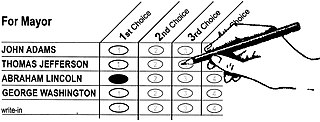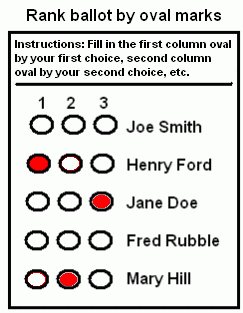Examples
Anti-plurality
Anti-plurality elects the candidate the fewest voters rank last when submitting a complete ranking of the candidates.
Later-No-Harm can be considered not applicable to Anti-Plurality if the method is assumed to not accept truncated preference listings from the voter. On the other hand, Later-No-Harm can be applied to Anti-Plurality if the method is assumed to apportion the last place vote among unlisted candidates equally, as shown in the example below.
| Examples | ||||||||||||||||||||||||||
|---|---|---|---|---|---|---|---|---|---|---|---|---|---|---|---|---|---|---|---|---|---|---|---|---|---|---|
Assume four voters (marked bold) submit a truncated preference listing A > B = C by apportioning the possible orderings for B and C equally. Each vote is counted A > B > C, and A > C > B:
Result: A is listed last on 2 ballots; B is listed last on 3 ballots; C is listed last on 3 ballots. A is listed last on the least ballots. A wins.
Now assume that the four voters supporting A (marked bold) add later preference C, as follows:
Result: A is listed last on 2 ballots; B is listed last on 5 ballots; C is listed last on 1 ballot. C is listed last on the least ballots. C wins. A loses.
The four voters supporting A decrease the probability of A winning by adding later preference C to their ballot, changing A from the winner to a loser. Thus, Anti-plurality doesn't satisfy the Later-no-harm criterion when truncated ballots are considered to apportion the last place vote amongst unlisted candidates equally. |
Borda count
| Examples | ||||||||||||||||||||||||||||||||||||||||||||||||||||||||||||
|---|---|---|---|---|---|---|---|---|---|---|---|---|---|---|---|---|---|---|---|---|---|---|---|---|---|---|---|---|---|---|---|---|---|---|---|---|---|---|---|---|---|---|---|---|---|---|---|---|---|---|---|---|---|---|---|---|---|---|---|---|
This example shows that the Borda count violates the Later-no-harm criterion. Assume three candidates A, B and C and 5 voters with the following preferences:
Assume that all preferences are expressed on the ballots. The positions of the candidates and computation of the Borda points can be tabulated as follows:
Result: B wins with 7 Borda points.
Assume now that the three voters supporting A (marked bold) would not express their later preferences on the ballots:
The positions of the candidates and computation of the Borda points can be tabulated as follows:
Result: A wins with 6 Borda points.
By hiding their later preferences about B, the three voters could change their first preference A from loser to winner. Thus, the Borda count doesn't satisfy the Later-no-harm criterion. |
Copeland
| Examples | ||||||||||||||||||||||||||||||||||||||||||||||||||||||||||||||||||||||||||||||||||||||||||
|---|---|---|---|---|---|---|---|---|---|---|---|---|---|---|---|---|---|---|---|---|---|---|---|---|---|---|---|---|---|---|---|---|---|---|---|---|---|---|---|---|---|---|---|---|---|---|---|---|---|---|---|---|---|---|---|---|---|---|---|---|---|---|---|---|---|---|---|---|---|---|---|---|---|---|---|---|---|---|---|---|---|---|---|---|---|---|---|---|---|---|
This example shows that Copeland's method violates the Later-no-harm criterion. Assume four candidates A, B, C and D with 4 potential voters and the following preferences:
Assume that all preferences are expressed on the ballots. The results would be tabulated as follows:
Result: B has two wins and no defeat, A has only one win and no defeat. Thus, B is elected Copeland winner.
Assume now, that the two voters supporting A (marked bold) would not express their later preferences on the ballots:
The results would be tabulated as follows:
Result: A has one win and no defeat, B has no win and no defeat. Thus, A is elected Copeland winner.
By hiding their later preferences, the two voters could change their first preference A from loser to winner. Thus, Copeland's method doesn't satisfy the Later-no-harm criterion. | ||||||||||||||||||||||||||||||||||||||||||||||||||||||||||||||||||||||||||||||||||||||||||
Schulze method
| Examples | ||||||||||||||||||||||||||||||||||||||||||||||||||||||||||||||||||||||||||||||||||||
|---|---|---|---|---|---|---|---|---|---|---|---|---|---|---|---|---|---|---|---|---|---|---|---|---|---|---|---|---|---|---|---|---|---|---|---|---|---|---|---|---|---|---|---|---|---|---|---|---|---|---|---|---|---|---|---|---|---|---|---|---|---|---|---|---|---|---|---|---|---|---|---|---|---|---|---|---|---|---|---|---|---|---|---|---|
This example shows that the Schulze method doesn't satisfy the Later-no-harm criterion. Assume three candidates A, B and C and 16 voters with the following preferences:
Assume that all preferences are expressed on the ballots. The pairwise preferences would be tabulated as follows:
Result: B is Condorcet winner and thus, the Schulze method will elect B. Hide later preferencesAssume now that the three voters supporting A (marked bold) would not express their later preferences on the ballots:
The pairwise preferences would be tabulated as follows:
Now, the strongest paths have to be identified, e.g. the path A > C > B is stronger than the direct path A > B (which is nullified, since it is a loss for A).
Result: The full ranking is A > C > B. Thus, A is elected Schulze winner.
By hiding their later preferences about B and C, the three voters could change their first preference A from loser to winner. Thus, the Schulze method doesn't satisfy the Later-no-harm criterion. |






